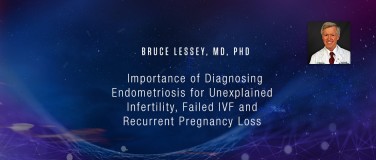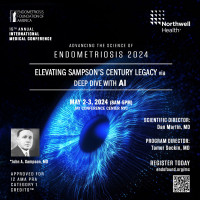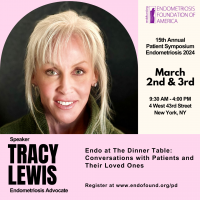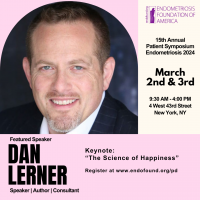Avner Hershlag, MD - IVF and Endometriosis
Endometriosis Foundation of America
Medical Conference 2019
Targeting Inflammation:
From Biomarkers to Precision Surgery
March 8-9, 2019 - Lenox Hill Hospital, NYC
https://www.endofound.org/medicalconference/2019
Thank you, Dr.Seckin for inviting me. It is quite humbling to follow Dr. Boone and Dr. Taylor who have pretty much spent their career so far in studying endometriosis. And we kind of have to make a quick switch here from what Dr. Taylor was saying actually as endometriosis ... as a systemic complicated disease to what I've been asked to speak about which is the very localized endometrioma and how it affects our IVF. And the switch is probably two-fold because we also have to switch from mice to women.
Endometrioma, I've chosen to address the following issues. What is the ovarian toxicity? And then specifically, does it affect air quality? What happens to fertility potential to the AMH following surgery? Should we choose surgery or IVF as a first treatment of the patient with endometrioma who is seeking to have a child? And whatever our recommendation is, what are the exceptions to this rule? If you don't do surgery before ART, what are the risks involved? And then finally, if you fail to ... if a patient fails IVF, should we then resort to surgery or reconsider our approach?
First of all, ovarian toxicity and I'll probably touch upon some of the molecular references that have been made already or will be made later on in the day. First and foremost is that the endometrioma comprises a toxic network that affects the ovary and the follicles and egg production in so many different ways. The major actors include the ROS, and the cytokines, an inflammatory network that is quite complex and involved.
Now genetic changes that ... molecular changes that have been seen in endometriotic cells that are lining the endometriomas include DNM mutations, alterations in angiogenesis, changes in gene expression profile, hormone receptive ... receptivity as we have seen in Dr. Taylor's talk, changes in hormone biosynthesis and oxidative stress and iron. Now when you look at the toxic contents of the ovary pouring in ... of the endometrioma, pouring into or interacting with the rest of the ovary, you can only imagine how pretty much different perspectives of both the stroma and the follicles are being affected.
Is the air quality affected? And the answer is absolutely. There's a lower rate of the number of mature oocytes and oocytes that are normal morphologically. In fact, in many cases we see and we hear from the embryologist, the eggs are brown. And that is this slide should say actually it's staged three to four mainly not one to four but the more severe ones. And also some refractile bodies in especially observed in stage four. In endometriosis stage four, it's been found that eggs are much worse than in stages one to three. Now, when you do conventional IVF and for those of you who don't do IVF, it's simply inseminating eggs. It's kind of the old way that IVF was done and just putting sperm on top of eggs, of course, it's processed sperm. Fertilization is reduced. However, when you ICSI direct injection of sperm into the eggs, fertilization rate is about the same.
The interesting thing and it's really challenging to so much of what has already been shown in the other mentioned lectures, is with all of the deficits that have been found, is that on clinical basis, reports time and again, show that on a clinical basis you don't have an impact, not an implantation rate, not on clinical pregnancy rate, not miscarriage rate, not the rate of malformations in the babies born, and not on live birth rate, which is if you want the of our field. That's overall. Of course, there are many exceptions. But that's a very important statement because maybe in our discussion session we'll address that discrepancy between the science and the clinical presentation.
So the conclusion is that in endometriosis patients, particularly those with severe endometriosis the eggs are of lower quality. However, once the eggs are fertilized, we don't see any further impairment of pre-implantation embryo development and pregnancy outcome right up to live birth and that's a very encouraging message for our patients especially on this special day.
The other encouraging information, this is not just endometriomas but this is work that is looked at the rate of aneuploidy, the rate of abnormal chromosomes in patients with endometriosis, in embryos of patients with endometriosis compared to control. And the interesting thing is that there is no difference in all age groups between abnormal chromosomes in embryos resulting from patients with endometriosis and the controls. And again, that is a very encouraging message.
Now, meta-analyses of IVF outcomes in patients with advanced stage endometriosis has shown that there are inferior outcomes with moderate to severe endometriosis, lower implantation rate and lower birth rate, especially in advance stage endometriosis. Stages three and four has been shown that both implantation pregnancy rates can be reduced in up to 21%. That was endometriosis.
Now, in meta-analyses of endometriomas, which is the specific topic we are addressing, there were few oocytes and few embryos, however, clinical pregnancy rate and live birth rate have not been affected. Patients who underwent surgery were excluded in those series. So you can question the validity of this study because it would make sense that the more severe endometrioma cases were the ones that were operated upon and therefore this is not a complete report. And also, we know that the larger the endometrioma, the few the number of follicles in the ovary. So from a clinical perspective, it is reasonable to conclude that reproductive prognosis of IVF would be worse with more advanced ... the more advanced endometriosis and the more increase is the endometrioma size.
What about AMH after surgery? When you have endometrioma in one ovary only, there is a 30% fall in your AMH ... in the patient's AMH level. When it's on both sides, it's been reported up to 44%. A report specifically on endometriomas that are larger than 5 cm has shown a drop in 23% but overall it's been concluded in this review at that ovarian cystectomy for endometriomas will cause significant damage to ovarian reserve up to 40% fall in the AMH. And of course, your concern is that women with borderline function, to begin with, you may fall into menopause after surgery and I don't know how many of the surgeons here have had that devastating experience. I've had it once or twice in my career and it hasn't been pretty.
So what should you do first when the patient presents for fertility treatment and has a large endometrioma by ultrasound? Well, there are three meta-analyses that show that there's a lower number of mature eggs in the surgery group and there were no differences in pregnancy rates or in a live birth. Surgical intervention for endometriosis failed to improve reproductive outcome. What are the exceptions to this conclusion? Well, first of all, sorry for the typo, women in severe pain and I know that maybe has now the magic drug but if conservative management fails, you may end up having to do surgery and extensive surgery such as what Dr. Seckin does here probably every week.
Then the other issue that bothers me a lot as a clinician, is excluding malignancy. Unfortunately, I'm not aware of any way of excluding malignancy in when you have a suspected endometrioma besides tissue diagnosis. And of course, there are criteria published that are beyond our scope today for elevating that suspicion and taking such a patient to surgery.
Now, ESHRE which is the European organization of infertility in 2014, recommended surgery when the endometrioma is over 3 cm and they mentioned the reasoning for reducing infection rate from obviously in IVF, sticking the needle into the endometrioma, increasing access to follicles because a large endometrioma is in the way and improving response to control of varying hyperstimulation that I think those of us who do IVF would probably argue, may not be the case. And then of course, they were talking about poor oocytes and embryo quality and implantation failure.
What about failed IVF? A patient who originally was not taken to surgery and did not succeed in IVF. There is work from this group in Israel where they took 78 women with severe endometriosis, stages three and four, who were symptomatic and failed IVF, and they performed on all of them extensive laparoscopic surgery and that resulted in 33 women, or 42% conceiving following the surgery. Three of them conceived spontaneously and 30 from IVF. So it makes a lot of sense that symptomatic women with severe endometriosis and repeat implantation failure might benefit from laparoscopic surgery.
This graphic from Dr. is kind of interesting because it shows you the problem with yes operating and not operating on the patients. Obviously, we just talked about the risk of not operating on the patient which will include the risk of puncturing an endometrioma and there have been a few pretty disastrous cases around the country that I'm aware of from an infected endometrioma. Remember that the needle goes through the vagina which is not sterile. Access to follicles is a big problem and you may actually miss quite a few eggs if you don't want to go through the endometrioma and the follicles are behind it. And of course the endometriosis can get worse in your patient and you can even have a ruptured endometrioma. Not very common but it can happen.
On the other hand, the risks of surgery as we ... some of which we've already said, obviously there are the surgical risks. And then beyond that is the issues delaying the IVF treatment, reducing the fertility potential and the AMH and the number of eggs that we get. And the fact that there hasn't really been shown in most patients benefit, a clinical benefit from the operation. So that is to conclude, thank you.










